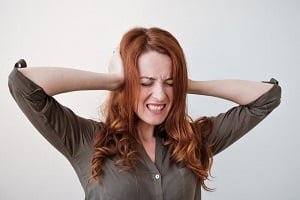Misophonia: Like Nails on a Chalkboard
Misophonia: Like Nails on a Chalkboard

Everyone’s skin crawls when they hear nails on a chalkboard (remember chalkboards?). But if your body reacts with extreme discomfort at the sound of everyday noises, like chewing, slurping coughing and tapping, you might be suffering from Misophonia, literally translated as “the hatred of sounds.” Although not recognized as a genuine disorder, the symptoms are genuine for those who suffer. Negative emotions, thoughts and physical reactions are triggered by specific sounds and they can be overwhelming.
One of my patients summed up the feeling, “I felt so agitated when I heard people eating, I wanted to punch them. I just couldn’t be around it.”
The response from a trigger sound can range from moderate discomfort to annoyance to all-out rage and panic. The feeling permeates your body, like when you hears nails on a chalkboard, and you just want to lash out at the person creating the sound. At the same time, the person creating the sound is completely oblivious to the sufferer’s discomfort and baffled by their agitation which can lead to conflict between loved ones.
Kelly Ripa, actress, talk show host and producer, is the most famous sufferer of this condition and she shared her struggles on the news program, 20/20:
“The sounds of swallowing and chewing make me insane…. My gut reaction is to yell... When my husband eats a peach, I have to leave the room.”
Research
The little research on misophonia has concluded that upon hearing sensory stimuli people react with a fight or flight response, similar to those with anxiety disorders. The researchers at Duke University’s Sensory Processing and Emotional Regulation Program state, “There is no single specific behavioral or device-based treatments that have been rigorously tested scientifically and shown to efficaciously treat Misophonia.” Additionally, “there is no scientific evidence that any specific medication treats Misophonia.”
This does not mean that treatment cannot be successful. It only means that no treatments have been “rigorously tested scientifically.”
My Personal Experience Treating Misophonia
In my practice I have had great successes using Cognitive Behavioral Treatment (CBT) and Exposure and Response Prevention (ERP) the same treatment used in treating anxiety disorders. Too often people seek treatment that involves sound masking which reduces their exposure to triggering sounds with ear plugs or special ear devices the emit a white noise. This only serves as a band-aide and does not solve the problem. CBT and ERP aim to change people’s thought patterns and slowly expose them to triggering sounds. As people learn to tolerate the triggering sounds they begin to acclimate and soon they are no longer bothered by them. If you are suffering with Misophonia you can find a therapist on the ADAA website who treats anxiety and OCD exclusively. They will know how to help you. You can also reach out to the Misophonia Institute at Mmisophoniainstitue.org.











